We’ve been diving in and around Dauin for about 3 months now, and figured it was about time we let you all know a little bit more about the dive sites in the area.
There are about 13 dive sites along the coast of Dauin, 8 of which are marine sanctuaries, and another 12 sites at the nearby Apo Island (not to mention several more sites at Siquijor – which I’ll try to do in another post). There are several great walls, steep slopes, gradual slopes and huge coral gardens all teeming with life. A macro lover’s paradise, as most of the creatures here are on the small side, however there are plenty of turtles, and it’s been said an occasional manta sighting at Apo.
All the dive sites are easily accessible from which ever resort you choose to stay at, ranging from a shore entry in front of your resort, to a 5-10 min boat ride. The sites at Apo can be reached in about an hour and are generally done on a two dive trip. The water temperature is usually around 27°C and diving here can be done all year round.
Considered to be some of the best diving in the Philippines (with a few sites considered world-class), you definitely wont get bored diving in Dauin.
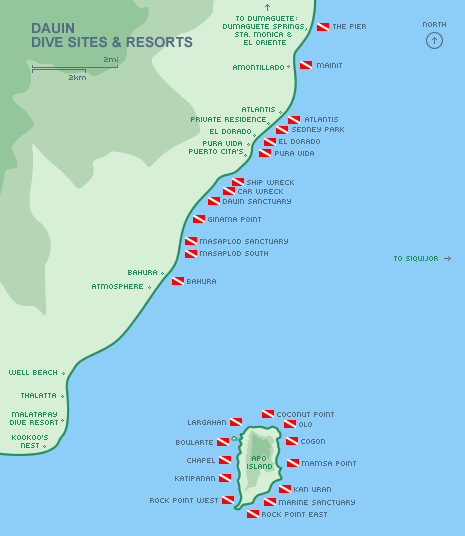
The Pier
Rating: ![]()
Depth: 5-20m
Current: gentle to moderate
Visibility: 5-15m
Known as one of the best dive sites in the Visayas, the Dumaguete Coconut Mill Pier (DuCoMi Pier) is a haven for underwater Photographers. The site is made up of the main pier and two smaller docking piers, one at the north, linked by a thin area of natural reef, and one at the south. The pillars of the piers are densely overgrown with beautiful sea fans, colorful sponges and lots of soft & hard corals, making it the perfect environment for all kinds of creatures.
Diving here is restricted to when ships are not docked and limited to one group at a time. Divers must also be Advanced Certified to dive here.
What to see here:
Moray eels, frogfish in different colors, many nudibranches, scorpion fish, devil fish, pipe fish, bat fish, seahorses, juvenile travellies, octopus, harlequin ghost pipe fish, harlequin shrimps, whiskered pipe fish, flamboyant cuddle fish, sea snakes and juvenile bat fish.
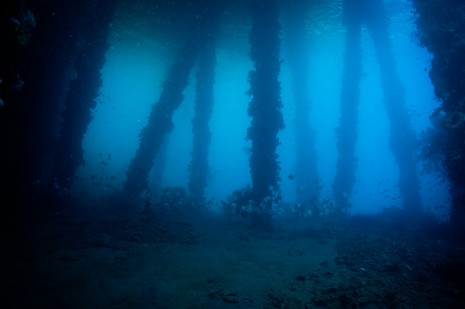
Mainit
Rating: ![]()
Depth: 3-30m
Current: Moderate to Strong
Visibility: 5-15m
A sandy slope that descends down to numerous elevated rock formations, covered in corals and anemones, interspersed with sandy patches.
What to see here:
The main attraction are the schools of barracuda and the underwater hot springs as well as puffer fish, rabbit fish, cat fish, garden eels, leopard sweetlips, juvenile bat fish, ribbon eels, shrimps, crabs, flounders and nudibranches.
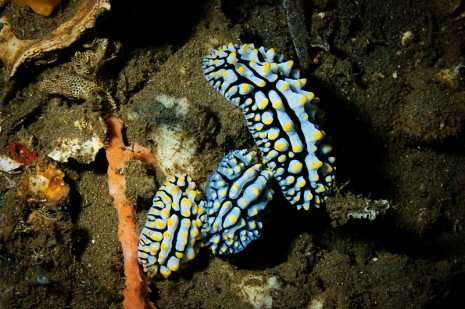
Atlantis
Rating: ![]()
Depth: 5-20m
Current: gentle to moderate
Visibility: 5-15m
Sea grass in the shallows with large areas of stag horn and other hard corals as you go deeper. There is also an artificial reef made up of old truck tires nicely covered with hard and soft corals. A popular site for night dives.
What to see here:
Mandarin fish, lionfish, scorpionfish, many nudibranchs, schools of catfish, freckled porcupinefish, big schools of yellow tail snappers, blue spotted stingrays, moray eels, ringed pipefish, crocodile fish, juvenile batfish, devilfish, ghost pipefish, frogfish, ribbon eels, twin spotted goby, double spotted lionfish, comet fish, blue ringed octopus, spanish dancer.
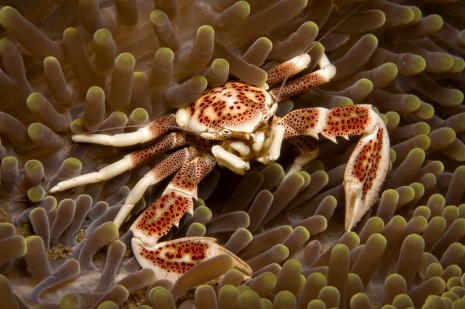
Sedney Park
Rating: ![]()
Depth: 5-22m
Current: gentle to strong
Visibility: 10-25m
A steep sandy slope with a bed of soft and hard corals. Similar to both Atlantis and El Dorado. Also popular for night dives.
What to see here:
Moray eels, lionfish, crabs, shrimps, clown (anemone) fish, nudibranchs, leaf fish, Indian walkmen, stone fish, and if you’re lucky spanish dancer.
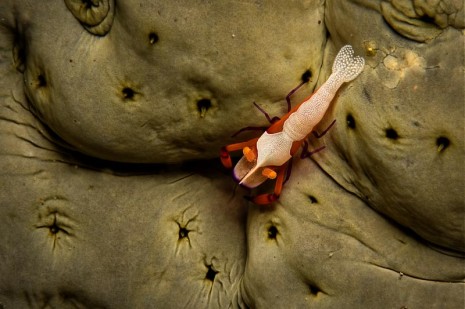
El Dorado
Rating: ![]()
Depth: 5-22m
Current: moderate to strong
Visibility: 5-20m
A gentle slope covered with large areas of stag horn coral as well as many smaller mixed coral blocks. There is also a small wreck, the old Dive Society speed boat, which is home to many batfish and large groupers. Also keep your eyes out for the resident turtle.
What to see here:
Different types of frogfish, turtles, banded pipefish, many nudibranchs, different types of snappers, oriental sweetlips, scorpionfish, moray eels, flounders, snake eels, crabs and shrimps, flamboyant cuttlefish, stargazer, ghost pipefish, seahorses, crocodile fish, juvenile harlequin sweetlips.
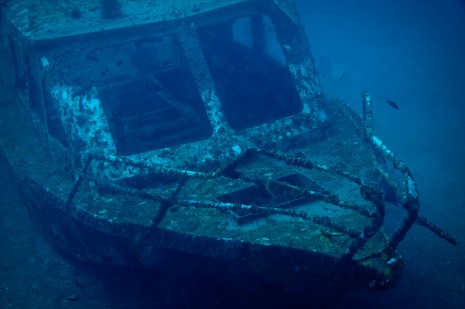
Pura Vida
Rating: ![]()
Depth: 5-30m
Current: moderate to strong
Visibility: 5-20m
An artificial reef consisting of old tires, concrete blocks, a banca wreck and a car wreck, spread over an 80m wide area.
What to see here:
Lionfish and big snappers in and around the wrecks. Moray eels, shrimps, anglerfish, crabs, cuttlefish, sea horses and ghost pipefish, Anglerfish, leaffish, clownfish.
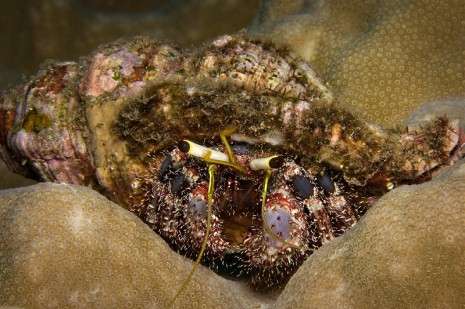
Ship Wreck
Rating: ![]()
Depth: 32m
Current: gentle to moderate
Visibility: 5-15m
The remains of a traditional filipino fishing boat (banca) in poor condition, lie on a sandy area at about 25m. This dive site is often combined with the Car Wreck.
What to see here:
Big lionfish, moray eels, shrimp, frogfish, ghost pipefish, nudibranches, filefish, crabs, and sometimes sea horses.
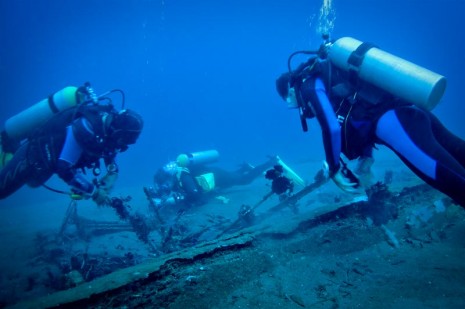
Car Wreck
Rating: ![]()
Depth: 6-30m
Current: gentle to moderate
Visibility: 5-15m
About 10 meters from the ship wreck are 2 car wrecks along with tires, fuel tanks, rims and other debris.
What to see here:
Durban dancing shrimps, banded boxer shrimps, nudibranchs, moray eels, sand divers, juvenile emperor angelfish, blue spotted stingray, crocodile fish, clown frogfish, harlequin ghost pipefish, banded pipefish, double ended pipefish, small cuttlefish.
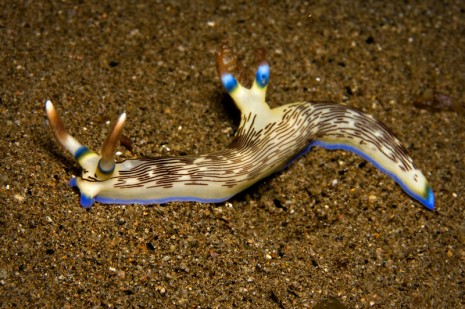
Dauin Sanctuary
Rating: ![]()
Depth: 3-20m
Current: gentle
Visibility: 10-25m
Sometimes divided into two dive sites (Dauin North and South), the Dauin Sanctuary is made up of 4 large coral beds separated by a sandy channel. Ideal for Open water divers and refresher courses.
What to see here:
Turtles, scorpionfish, pufferfish, rabbitfish, nudibranchs, catfish, garden eels, different types of triggerfish, juvenile batfish, devilfish, clown triggerfish, cuttlefish, ribbon eel.
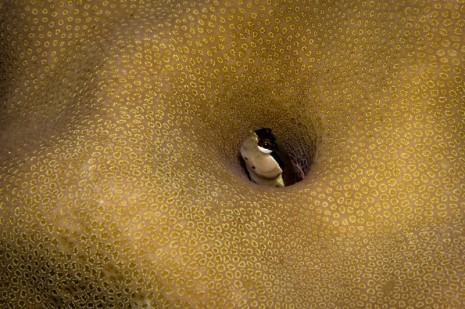
Ginama Point
Rating: ![]()
Depth: 5-22m
Current: depends on tide
Visibility: 10-25m
Ginama means man made. This site is a huge artificial reef made up of truck tires overing an area of around 300 square meters. The tires have been there for more than a decade and are completely covered in corals and sponges.
What to see here:
Angler fish, ghostpipefish, devil stinger, moray eels, blue spotted rays, Jack fish, snappers, scorpionfish, batfish.
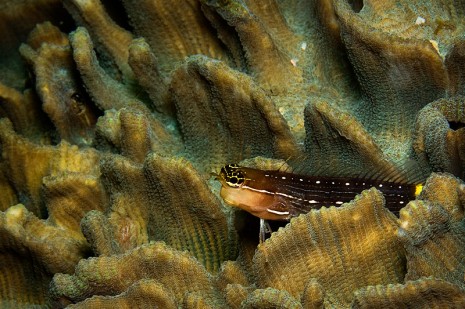
Masaplod Sanctuary (North)
Rating: ![]()
Depth: 5-25m
Current: moderate to strong
Visibility: 10-25m
One of the oldest sanctuaries in the area, teeming with life. A slopping patchy reef that descends to about 25m, with large coral formations throughout.
What to see here:
Seahorses, double ended pipefish, large mangrove snappers, big schools of yellowtail snappers, blue spotted stingrays, nudibranches, scorpion fish, sweetlips, porcupine fish, ringed pipefish, batfish, large schools of juvenile travellies, moray eels, turtles, ghost pipefish, sea snakes, mantis shrimps, big barracudas, stargazers, thorny cow fish.
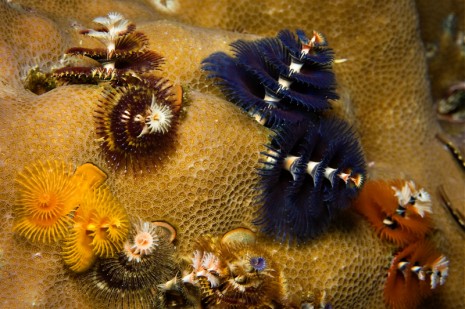
Masaplod South
Rating: ![]()
Depth: 5-26m
Current: gentle to moderate
Visibility: 5-20m
A similar site, just bit further south, with just as many fish. Soft coral fields with mixed coral blocks, slopping up towards a sandy bed of sea grass.
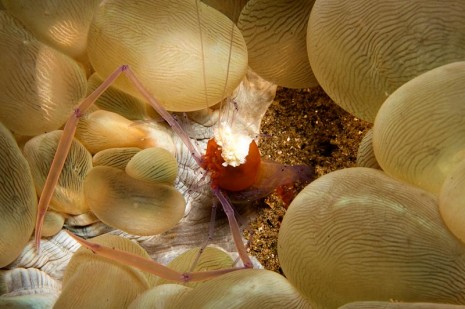
What to see here:
Moray eels, turtles, ghost pipefish, anglerfish, nudibranches, sea snakes, scorpion fish, sweetlips, porcupine fish, ringed pipefish, batfish, large schools of juvenile travellies and sometimes a rare bluering octopus.
Bahura
Rating: ![]()
Depth: 5-22m
Current: moderate to strong
Visibility: 10-25m
A slopping reef of hard coral blocks that descends to a sandy bed of soft corals.
What to see here:
Mantis shrimp, nudibranches, leaffish, scorpionfish, small lion fish, ghost pipefish, angler fish and lone baracudas.
Apo Island
Coconut Point
Rating: ![]()
Depth: 5-35m
Current: very strong
Visibility: 15-35m
Nicknamed ‘The Washing Machine’, this site almost always has a strong current and can be very challenging due to both up and downward currents. A slopping reef that gives way to a rock wall. Halfway through the dive you will pass over a sandy channel that runs between two rock cliffs.
What to see here:
Bump-head parrotfish, jacks and snappers, sweetlips, emperor fish, fusiliers, barracuda, tuna, rainbow runners, turtles, sea snakes, batfish, potato grouper, mapoleon wrasse.
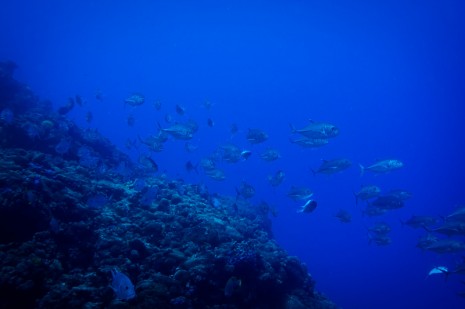
Olo
Rating: ![]()
Depth: 15-30m
Current: very strong
Visibility: 10-35m
Olo means “head” is Visayan, and this dive site lies and the head of Apo Island. Only for experienced divers as the current can be quite strong here where it splits to Coconut Point one way and Cogon the other. Made up of two walls, with a sandy slope full of staghorn coral dividing them.
What to see here:
Lots and lots of fish, Triggerfish, pufferfish, sweetlips, snappers, turtles, emperor fish, butterflyfish, and more.
Cogon
Rating: ![]()
Depth: 15-35m
Current: moderate to very strong
Visibility: 10-35m
Subject to strong currents, this dive is only for experienced divers. This drift dive starts on a slopping reef of mixed corals and sponges and finishes on a wall of soft corals.
What to see here:
Big eye trevallies, banded seasnakes, turtles, snappers, boxfish, clown triggerfish, scribbled filefish, pyramid butterflyfish, longfinned bannerfish napoleon wrasse, cuttlefish, bumphead parrotfish, batfish, eagle ray, mantis shrimp, blue spotted stingray, flatworm, frogfish.
Mamsa Point
Rating: ![]()
Depth: 38m
Current: moderate to very strong
Visibility: 10-35m
A slopping reef and a steep wall of soft and hard corals, subject to strong currents. Mamsa, meaning jackfish in Visayan (the local dialect), is home to big schools of jacks.
What to see here:
Big schools of trevallies (Jacks), banded seasnakes, turtles, snappers, boxfish, clown triggerfish, scribbled filefish, pyramid butterflyfish, longfinned bannerfish napoleon wrasse, cuttlefish, bumphead parrotfish, batfish, eagle ray, mantis shrimp, blue spotted stingray, flatworm, frogfish.
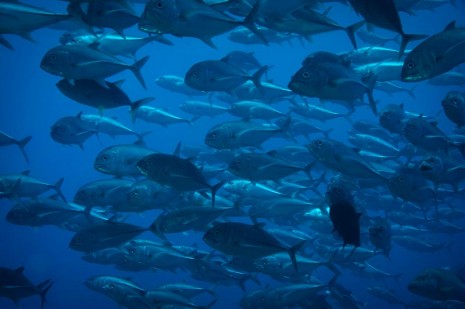
Kan Uran
Rating: ![]()
Depth: 25m
Current: moderate
Visibility: 10-20m
A steep slope with some beautiful soft and hard corals.
What to see here:
Many nudibranches, razor fish, rubble pipe fish, moray eels, rigid shrimp, scorpionfish.
Marine Sanctuary (Clownfish City)
Rating: ![]()
Depth: 5-25m
Current: gentle
Visibility: 10-25m
A slopping reef of diverse hard and soft corals. Some interesting overhangs and small caverns. At around 4-7m you’ll find “Clownfish City”. Huge anemone covered coral blocks that are home to many species of clownfish. Diving here is limited to 15 people per day.
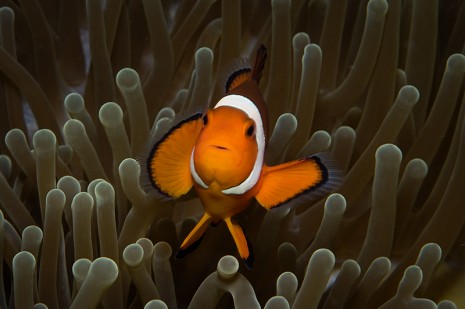
What to see here:
Clownfish, moray eels, fusliers, butterflyfish, angelfish, nudibranchs, scorpionfish, giant trevally, snappers, sweetlips, different species of surgeonfish, fantastic hard and soft corals, sea moth, flounder, napoleon wrasse, bump head parrotfish, turtle, frogfish, ghost pipefish, long nose hawkfish.
Rock Point East
Rating: ![]()
Depth: 5-35m
Current: gentle to strong
Visibility: 10-25m
The east side of Rock Point is a steep wall which plateaus at the tip of the point. Full of impressive hard and soft corals with lots of interesting macro stuff as well as numerous red-toothed triggerfish.
What to see here:
Turtles, red tooth triggerfish, pyramid butterflyfish, longfin bannerfish emperorfish, unicornfish, snappers, trevallies, grouper, nudibranchs, scorpionfish and stunning corals.
Rock Point West
Rating: ![]()
Depth: 5-30m
Current: gentle to strong
Visibility: 10-25m
This site can be combined with Rock Point East. A steep slope with beautiful soft corals in the shallows leading to deeper hard corals and sponges. The current increases towards the tip of the point, where you will usually find larger fish.
What to see here:
Nudibranchs, flatworms, scorpionfish, trevallies, snappers, grouper, pufferfish, white eye moray eel, batfish, turtles.
Katipanan
Rating: ![]()
Depth: 5-20m
Current: gentle to moderate
Visibility: 10-20m
A soft coral garden with lots of marine life. Perfect for beginners.
What to see here:
Turtles, big cuttle fish, dart fish, harlequin sweetlips, trigger fish, butterfly fish, goat fish, angel fish, bat fish, surgeon fish, sea snakes, comet fish and loads of damsel fish.
Chapel
Rating: ![]()
Depth: 5-35m
Current: gentle to moderate
Visibility: 10-20m
A gentle sandy slope that leads to a very steep slope, and then a wall with lots of small caves and overhangs. The flat reef on top of the wall is a prefect spot to explore during your safety stop.
What to see here:
Lionfish, scorpionfish, blue fin trevally, nudibranches, surgeonfish, black and white snappers, fusiliers, golden sweepers, garden eels, moray eel, turtle, batfish, sea moth, comet fish, frogfish, napoleon wrasse, bumphead parrotfish, giant trevally.
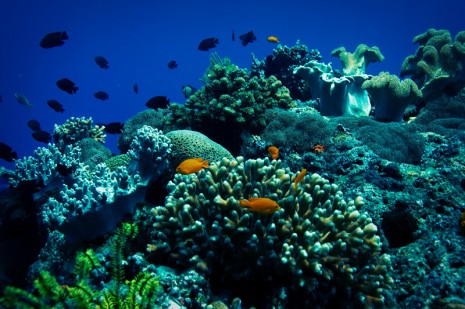
Boularte
Rating: ![]()
Depth: 30m
Current: gentle
Visibility: 10-20m
Boularte is the name of the big rock at the north east corner of Apo Island. A sandy bottoms several coral blocks scattered about. Good site for beginners.
What to see here:
Spotted garden eel, sweetlips, soliderfish and butterflyfish, pufferfish, turtles and seasnakes.
Largahan
Rating: ![]()
Depth: 10-30m
Current: moderate
Visibility: 8-20m
A small wall with beautiful coral blocks, that leads to a dark sandy area. Bubbles from underground geothermal activity rise from the sandy ground.
What to see here:
Nudibranchs, frogfishes, flatworms, scorpionfishes, blue ribbon eel, pufferfish, triggerfish, lionfish, different kind of groupers, parrotfish, mackrels.
Posted by: Kelly
I love how detailed you are with your diving excursions. I like the main map of showing where all the good diving spots are. Great work Kelly and Mike!
Thanks Jane! There are lots of great dive sites here, these are just the ones in our neighborhood!